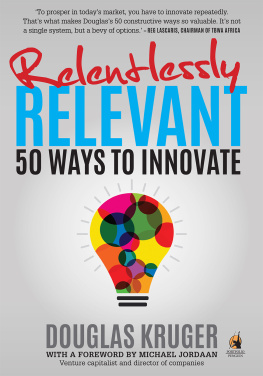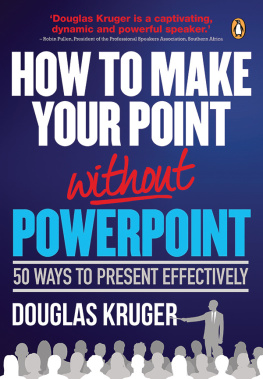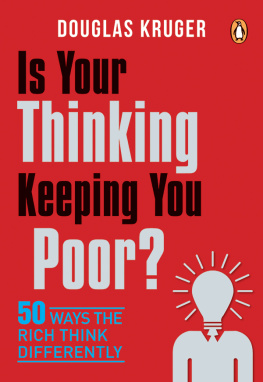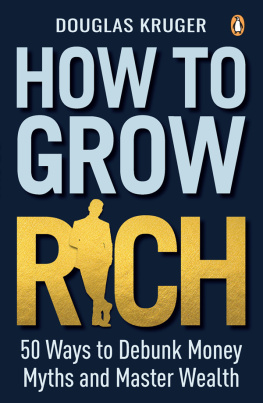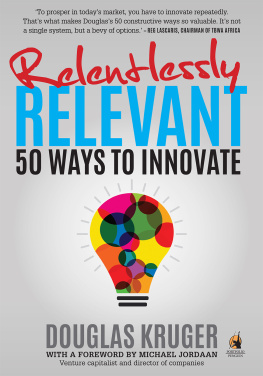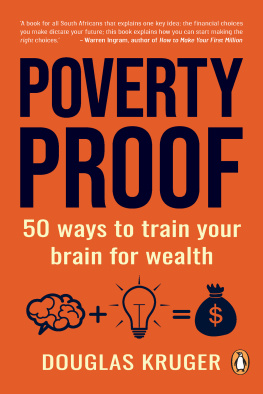Relentlessly
RELEVANT
Relentlessly
RELEVANT
50 WAYS TO INNOVATE
DOUGLAS KRUGER

Published by Portfolio Penguin
an imprint of Penguin Random House South Africa (Pty) Ltd
Reg. No. 1953/000441/07
The Estuaries No. 4, Oxbow Crescent, Century Avenue, Century City, 7441
PO Box 1144, Cape Town, 8000, South Africa
www.penguinbooks.co.za
First published 2015
Publication Penguin Random House 2015
Text Douglas Kruger 2015
Cover photograph iStock by Getty
All rights reserved. No part of this publication may be reproduced, stored in a retrieval system or transmitted, in any form or by any means, electronic, mechanical, photocopying, recording or otherwise, without the prior written permission of the copyright owners.
PUBLISHER: | Marlene Fryer |
MANAGING EDITOR: | Janet Bartlet |
EDITOR: | Mark Ronan |
PROOFREADER: | Kelly Norwood-Young |
COVER DESIGNER: | Sean Robertson |
TEXT DESIGNER: | Ryan Africa |
TYPESETTER: | Tessa Fortuin |
ISBN 978 1 4152 0836 6 (print)
ISBN 978 1 4152 0837 3 (ePub)
ISBN 978 1 4152 0838 0 (PDF)
To Marie Grey
It takes courage to look at an industry infant and see something worth investing in. Marie, you did have that level of courage. This book wouldnt exist without you and, to a large extent, neither would I. You are not just an industry leader: you are a shining star in the service of possibility thinking.
Im curious:
How odd can you be while still being able to use it constructively?
How fast can you learn from anarchy?
How great is your appetite for chaos, your tolerance for wading through bedlam until patterns emerge and you find your way?
Think you can cope?
Theres gold in them thar hills.
No innovation is really needed. Take the wheel. Other cavemen probably laughed at the inventor and said, Look at George with his wheel. Real men carry rocks on their backs! Tom Peters, The Circle of Innovation
In a sea of sameness, be a neon island with dancing natives setting off fireworks. When visiting rowboats are delighted, arm them with outboard engines to go tell others quicker. Douglas Kruger
FOREWORD
It is easier to copy something than to create something completely new.
At least, that has been the attitude of many businesses towards innovation. Big brands constantly regurgitate the value of their age-old experience, and there is the impression that it is less complicated and much more profitable for companies to simply imitate the products or services of others than to create their own. It seems perfectly reasonable to ask whether a business particularly a successful one should even try to fix something that is not considered broken, since any form of innovation is inherently risky. Corporations, and society at large, generally tend to reward success and punish mistakes. As a result, inertia, and just accepting things as they are, have become prevalent in both social and business behaviour.
Innovation, consequently, has grown from an abstract concept into a sound business stratagem utilised by corporations and big brands. It drives home the point that by not taking the risk of introducing something new or different to existent or potential markets, brand perceptions will stagnate and businesses will fail. Change is inevitable. And in business, as in life, not innovating is the greatest risk of all.
Douglas Krugers Relentlessly Relevant: 50 Ways to Innovate is an innovation in itself by looking beyond the hype that the entire phenomenon has inspired. While management consultants offer programmes to propel an innovative corporate culture, individuals are recruited for their creative problem-solving skills and advertising campaigns persistently trumpet ingenious product features, Douglass book offers something more pertinent. By providing real-world examples of companies who have adopted innovation, his book both demystifies this scary topic and actually encourages local businesses to try it out for themselves. It not only offers 50 ways for you to become an innovator, but it also does this in a manner completely relevant in a South African context drawing ideas from local corporations and the major international innovation gurus in order for you to apply it to your own business.
If you feel you are caught in a world of unproductive and stilted bureaucracy, this is a book you should read and then make your colleagues read. But dont stop there use it as a guide to take your own risks and make the changes that your consumers need and will appreciate.
Michael Jordaan
Venture capitalist and director of companies
January 2015
CONVERSATION IN A KITCHEN
Weltevredenpark, Saturday 27 September 2014
VANESSA KRUGER (pouring a glass of wine): So, how do you innovate?
DOUGLAS KRUGER: Well, thats a pretty big question. Im writing a whole book on innovation, which gives 50 different ways of going about it.
VANESSA: Sure, but explain it to me. How do you innovate?
DOUGLAS: Okay Well, you start by assuming that everything around you, everything you do, every rule you live by, the way things work, everything is a system, a convention. Its all invented by people. Then assume that were so immersed in our systems that we no longer see them. Theyre just how its done.
Start by zooming back and seeing the systems. Youll then realise that many are outdated or defunct. They only exist because of momentum. Theyre not law. Zoom back and look at goals, at what you want to achieve, instead of at how things have always been done.
When you think in terms of goals, and assume that the way youre currently doing things is only because they have always been done that way, you start to think around the systems. You start seeing patterns, motives, different perspectives. You start asking questions and the questions lead to change.
Also, you should be interested in different things. Read Dr Seuss as much as you read Malcolm Gladwell or Popular Mechanics. Remember when I first met Clem Sunter and he was still chairman of Anglo American? I told you he had a copy of AA Milnes Winnie-the-Pooh on his desk. Be interested in different things and youll start to see patterns in everything. Youll take an idea from one thing and apply it to another. Thats usually how it works.
And there are two types of innovation, really. Theres incremental innovation, which says, How do I make my car slightly more fuel-efficient? And theres radical innovation, which says, Why the heck do we need cars anyway? Why dont we just beam people across continents, like in Star Trek?
Oh, and then once youve got your great idea, thats when the real fight begins. You have to fight pretty much everyone in the universe because everyone will think its dumb and feel that youre using too much money on your costly nonsense. But keep it up and you can change the world and make money. And thats pretty much innovation.
VANESSA

